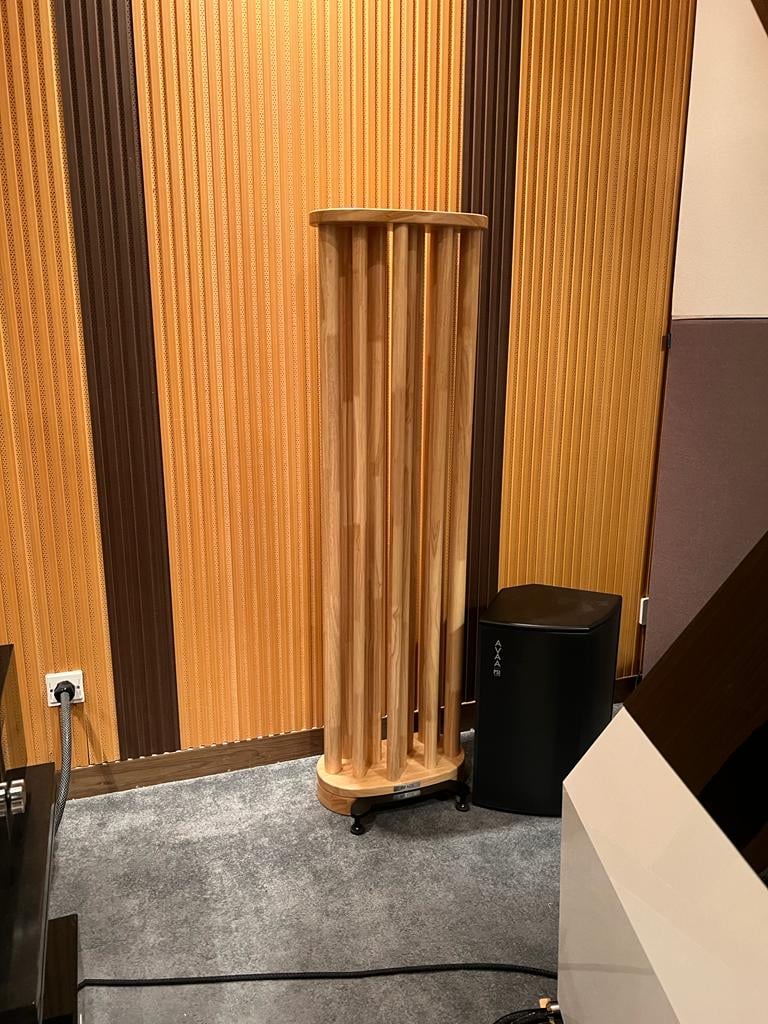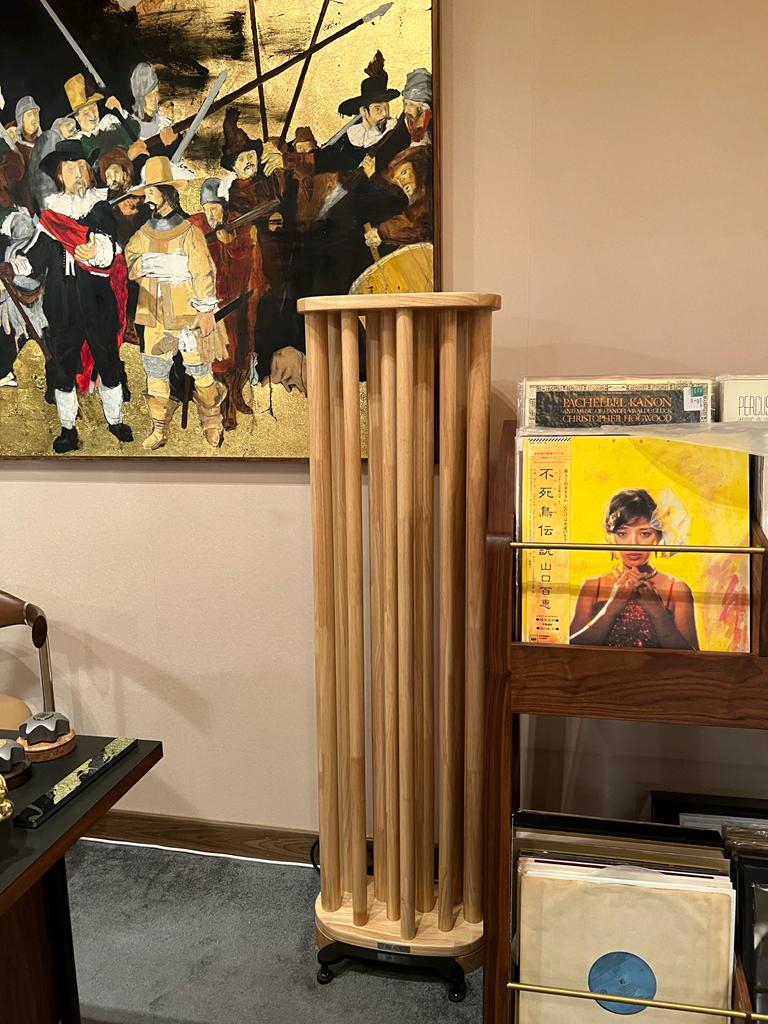Benediction of Acoustics Grove System
Benediction of Acoustics Grove System
Mr. Shigeta, founder of Nihon Onkyo Engineering (NOE) had rich experiences in the broadcasting industry since the 70s participating in big projects including Asahi Broadcasting (radio and TV), Channel 12 (TV Tokyo currently), King Studio, and Kawada-cho Studio of Fuji TV, etc alongside the design and site management of music recording studios. Nowadays NOE is solidly established as an engineering specialist in architectural acoustics and pioneer of studio design/construction in Japan.
The story of Acoustic Grove System, a sub division of NOE, began when Mr. Shigeta visited Kitayama in Kyoto. (北山杉のはじまりと歴史 | 京都北山丸太生産協同組合 kyotokitayamamaruta.com). He was shocked by the profound tranquility the very moment he stepped into the cedar forest. The acoustic calmness is far beyond everything he encountered in the past. The call of nature suddenly bestowed upon him with a sacred mandate to transform the acoustic of any physical interior space into a Kitayama cedar forest. This is a very challenging feat. He began conducting researches on forest acoustics utilising academic disciplines ranging from mathematics, architecture, and psycho-acoustics etc. I truly respect the scientific discovery spirit of Shigeta san aiming to achieve the seemingly impossible. As a result, I started reading academic studies on forest acoustic for a month.
How do trees reduce noise? They reflect, mask and absorb sound waves. Sound scatters in different directions by bounding off leaves, branches, trunks and the ground. When a sound wave hits these surfaces, some of the kinetic energy changes into a little bit of heat, which causes sound wave to decay faster thereby reducing noises. In a forest, there are three main categories of surfaces correlating with absorption and reflection of sound:
- Tree trunks
- Brunches and foliage
- The forest floor
The trunk is the most neutral surface because of its low absorption coefficient which maximises the intensity of sound reflection. In normal physical space, strong reflection creates noises but that is not the case in forest because the forest floor is very efficient in absorbing middle and low frequencies, conditional on moisture, roughness and vegetation. Empirical researches confirm tree bark (樹皮)also absorbs sound which is a function of thickness, tree age and roughness. Scientists discovered conifers 針葉 are better at absorbing noise than broadleaved trees in general. Specifically, larch (落葉松)is the best. Meanwhile, leaves and foliage absorb high frequencies usually above 2khz.

However products of AGS which consist of FS-1, FL-1 and MN-1 contain no leaves, bushes and a moisturised ground at all (except FS-1 has a small base at the bottom). As a result, absorption from them must be close to non-existent unless the bark of the tree-like columns absorbs some. Thus, I believe Shigeta san premised the design of AGS on a thesis of “scattering of sound waves by trunks reduces sound pressure level/standing waves.”

The subject of forest acoustics is fascinating. However, executing the very idea of transforming physical interior acoustic to a forestry acoustic environment is seemingly too abstract and almost sounds like an unattainable goal. NOE has been utilising wave motion simulation technologies to study the array configurations of tree columns and trunks diameter. I speculate even the texture of tree barks are taken into account. But that is just the beginning because minute differences of column materials and method of joinery also matter tremendously to the outcome. The AGS was created through colossus human effort in fundamental researches, infinite iterations of trial productions, and uncountable listening experiments.

After the AGS was installed in Divin Lab, flagship showroom of Audio Exotics in Hong Kong, my first feelings after a session on Edvard Grieg’s Peer Gynt Suite No.1, Op. 46 —“Morning Mood” conducted by Berlin Philharmonic under the baton of Herbert von Karajan was “profound tranquility”. Divin Lab was transformed into a natural landscape as though flutes and oboes resembling bird calls from a distant mountain. The string session is suggestive of a harmonious chorus of cicadas singing in near field. It is refreshing.
Unlike typical symphonic structure, the crescendo of “Morning Mood” occurs very early at the first forte which signifies breaking through of the sun. This masterpiece of Edward Grieg under Berlin Philharmonic never sounds so naturally exquisite ever before in Divin Lab. The orchestration for flutes, oboes, clarinets, bassoons, horns, trumpets, timpani, and the string section are presented in a picturesque manner with free flowing of music energy from each instrument session summoning a holistic symphonic power (the origin of musicality comes from energy). It penetrates my body thoroughly. Bass energy remains very focal in delivery from the point of origination all way till the last drop of it vanishing in air, which consequentially defines the very aura.

In retrospect, the freedom of energy flow was relatively muted without the AGS. It was clean, focus, picturesque but radiance of bass energy under 120hz lacks dynamic and volume in comparison. Before the AGS, bass standing waves were primarily tackled by PSI active bass traps which are effective at the corners of the room. When the AGS is put into action, I had to switch off (retire) 6 PSI completely because standing waves of bass are attenuated immediately by the FL-1 placed in front of the 18”bass driver of Divin Majestic, thereby lessening the needs for absorption. (I still retain two PSI at the back of Goebel on both channels.) When the pair of FL-1 are taken away, the clarity of the orchestra collapses and transient responses of bass instruments constipated. Resorting to PSI restores clarity at the expense of free-flowing of energy. Liveliness of music is compromised in general. This is not a small feat because long standing waves of bass are difficult to deal with. The FL-1 is magical and indispensable for serious listener. In fact, bass management has become much easier than anytime ever before.
Likewise, the placement of FS-1 at the first reflection point replaces the Artnovion’s Flow because the former preserves more high frequency energy which transpires the Lord Raven violin by Stradivarius under the command of Anne Sophie Mutter to convey more musical energy from mid range and above. The radiance of energy transpired by the Lord Raven violin probably reached the zenith. I am able to comprehend the prowess of this violin complimented by Mutter during interview. The FS-1 allows the potential of Air Blade Signature 180 degree augmentation tweeter to be fully developed.

Comments
-
Out of curiosity, I intentionally tested some studio recordings where heavy absorptions are usually deployed in the venue. To my surprise, I am able to discern much clearly what is happening in the studio recording, such as the distance between the vocal’s lips and the microphone, the type of mixing employed, and the degree of echoes applied. I also gain much better insights into the communications amongst band members/different chorus section. There is so much more information being unveiled. The AGS does not turn studio recording into a forestry acoustic space is good because it should not. When I was listening to “Jealousy” by Labrinth, his lyrical articulation of vowel has clearly more penetration power under the AGS than without. After elapsing two minutes, the emergency of bass instruments (probably synthesised bass, I am not 100% certain) delivers much more volume than before. Yet, contour of even very deep bass notes remains in lucidity.

The AGS is not just another “me too” acoustic products. It should deserve much wider recognition given Shigeta san’s novel concept. The simplicity of a few wooden column conceals not only nobility of ideas and complexity of researches, but also the brilliance of a mindset.

“We do not know what is happening to us”, the Spanish philosopher Jose Ortega y Gasset wrote in the disorienting year of 1929, adding, “and that is precisely what is happening to us”. I take great length to comprehend facts and theories alongside field researches to remind I always know what/why/how is happening to us in the realm of High End Audio.
0 -
Since diffusors generally require space in order to work properly I am wondering if any room size constraints have been observed with the AGS floor unit? I have a dedicated, acoustically treated listening room but it is small (5 meters deep x 3 meters wide). I am wondering if the AGS FL1 would be effective in a room this size?
0 -
Yes they are even more effective in smaller room.0
-
 AGS MN1 is designed to diffuse diffraction/reflection.https://en.m.wikipedia.org/wiki/Diffraction
AGS MN1 is designed to diffuse diffraction/reflection.https://en.m.wikipedia.org/wiki/Diffraction
The effectiveness of it not only improves imaging focus, but also bestows a soundstage protruding deep beyond the wall. It works in tandem with FL1 and FS1 to effectively address unwanted reflections and diffraction unruly bouncing everywhere. Tools of AGS diffuses energy evenly across whole frequency range as opposed to other absorption media that inherently exhibits different absorption coefficients across the frequency spectrum. Images within the stage are better anchored and surrounding ambience radiates beyond physical walls. The end result is a very engulfing space without borders. 0
0 -
Regardless Arteluthe Stilleto I considered it is a small size of 3 ways speaker , energy from music notes becomes transparent and wider by using AGS FL-1 and MN-1.
 0
0
